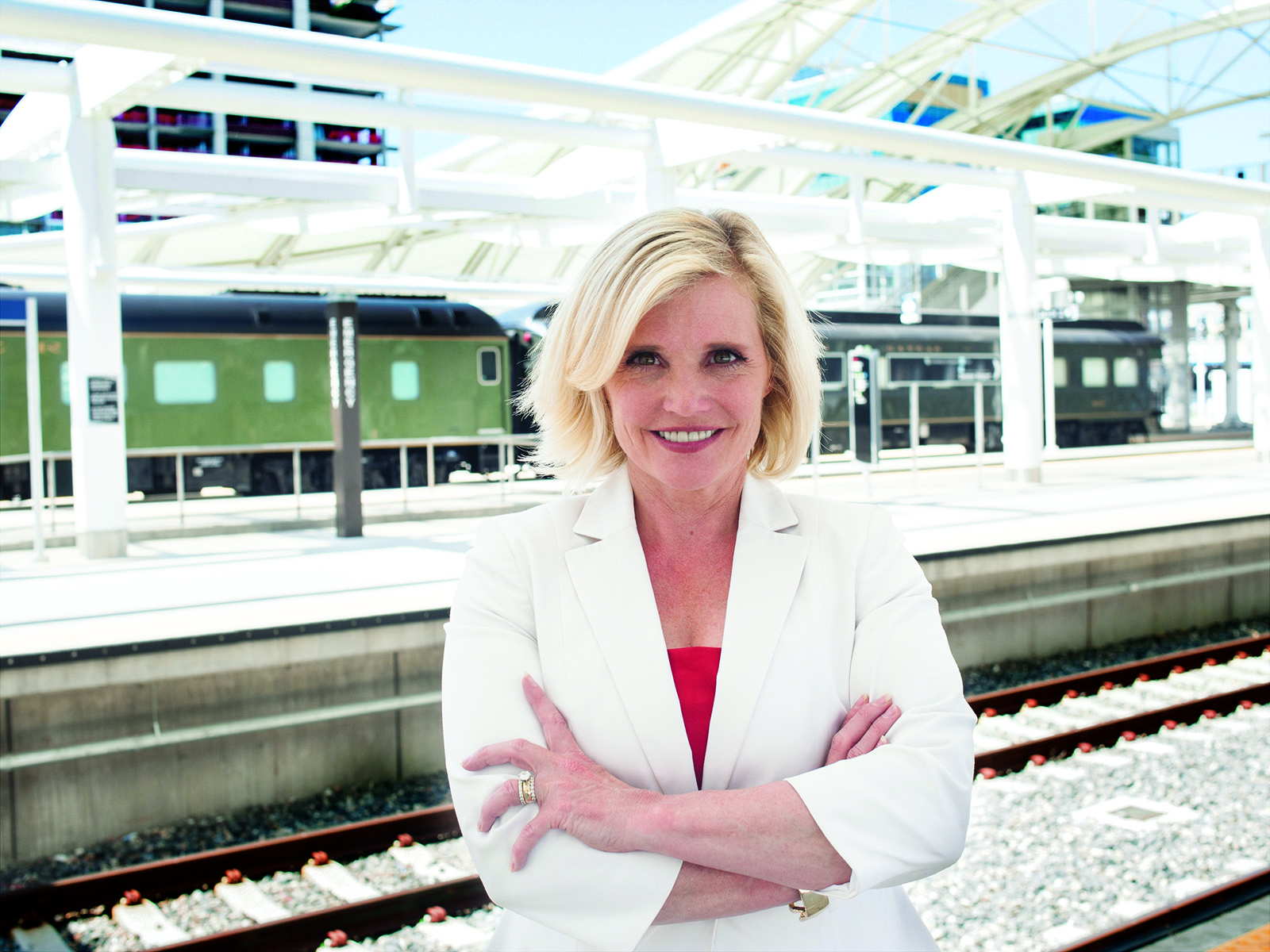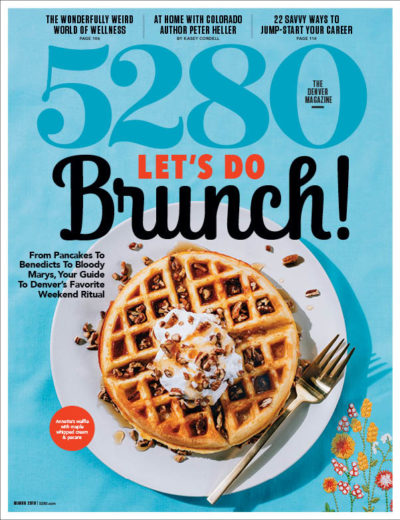The Local newsletter is your free, daily guide to life in Colorado. For locals, by locals. Sign up today!
Union Station’s intricate interior detailing is, in today’s parlance, Instagrammable. From the opulent, bell-shaped Beaux Arts chandeliers to iron detailing on arched windows to the bar booths inspired by old Pullman sleeping cars, the space evokes a feeling of grandness. Every detail in this modern iteration of the historic building seems intentional—except, perhaps, for one. Reminiscent of an airport’s moving walkway, the cramped corridor that conducts people to and from the bathrooms feels a little like an afterthought.
On a cold evening this past winter, a man and a woman walked shoulder to shoulder among this hallway’s throng. When she stopped to queue up outside the door to the women’s restroom, her companion couldn’t help but note: “There’s a big, long line.” Still bundled tightly in her puffy winter jacket, she cocked her head toward him. “Yeah,” she responded. “That’s what happens when you’re a lady.”
This scene repeats itself across Denver and other cities. Though women often require more time in the bathroom due to physiology, dress, and other factors, their restrooms are typically built using the same square footage as men’s (which can accommodate more people because urinals take up less space than individual stalls). It is such a ubiquitous issue that, for many people, it’s a running joke. But what if we stopped jesting and examined why this situation is generally accepted?
That’s exactly what Virginia Santy, a consultant and former professor of communication and women’s studies at Metropolitan State University of Denver, does. She wants to understand how we got to a place where, every day, women encounter too-heavy doors (often built to be opened easily by the average middle-aged man, who weighs 201.7 pounds), endure frigid office temperatures (standards set in the 1960s when fewer women worked in offices), and lose time searching for spaces to breastfeed. Cumulatively, these design choices force women to endure what Santy calls “death by a thousand paper cuts.”
These cuts, one after the other, don’t just make women uncomfortable or frustrated. “My argument is it shows women we don’t value them,” Santy says. “We don’t even value 50.8 percent of the population enough to see the ways we might be presenting little challenges to it. And we certainly don’t value it enough to address them.”
Even worse, living in a world not designed for you can be downright dangerous. Government-funded clinical trials and medical studies weren’t required to include women until the early 1990s. The first prototype of a crash test dummy with a female figure wasn’t built until 2012, despite the fact that female bodies are 47 percent more likely to sustain serious injuries in a crash. According to the Centers for Disease Control and Prevention, women also suffer more work-related repetitive motion injuries.

What if Denver could be different? Santy wondered. In November 2016, she set out to make a tangible change in one sector and co-founded Women in Kind (WinK), a north Denver co-working space planned by and for women with amenities like play spaces for children and dry cleaning delivery (it opened in 2017). But she knew a few offices weren’t enough to address an ecosphere of inequality and that the Mile High City would need a systemic overhaul, from transportation and infrastructure development to equal pay and public policies. So Santy took her big idea—to make Denver the first city in the country to be comprehensively designed for women—to someone who could help make it a reality.
Tami Door, CEO and president of the Downtown Denver Partnership (DDP), has built her career fostering innovative approaches to city-building. In her 14 years leading the DDP—the nonprofit tasked with forming a robust center city—she’s co-founded Denver Startup Week, the country’s largest free entrepreneurial event, and spearheaded the creation of a 20-year vision plan for the area. When Santy pitched Door in November 2017 about adapting downtown Denver so it would be significantly more friendly to females, Door embraced the idea. It was one she’d already been mulling because it aligned with the economic inclusivity work she’d long supported.
The resulting initiative, named Designing a City for Women as an Economic Imperative, is Door’s latest attempt to make Denver stand out in a competitive business environment: Companies are not only looking for locations that serve their needs, but also for the intangible characteristics (quality of life, a vibrant dining and culture scene, access to the outdoors) that entice workers. “We’re trying to identify ways Denver could really differentiate itself,” Door says. “Our goal is to be the first center city in the world that has a strategy and a platform specifically focused on women and meeting their needs.”

Designing a City for Women as an Economic Imperative is much more than a marketing effort. Women make more than 70 percent of consumer spending decisions, and although women’s participation in the labor force overall is declining, the number of women-owned businesses is on the rise. A city that is more accessible to women, Door says, would be a selling point for both big and small corporations to move to Denver—and for homegrown companies to stay. “Ultimately, the largest population of opportunity is women,” she says. “If we build a city that supports women, it will then attract women to our workforce, it will help retain women in our workforce, and it will help grow women into our workforce. That’s an economic advantage.”
And it is an edge that other metro areas have already recognized. Since the early 1990s, Vienna has implemented more than 60 pilot projects, such as Women-Work-City, an apartment complex created by and for women, that aim to rethink urban planning with the whole population in mind. (The efforts have been so effective that the United Nations Human Settlements Programme included Vienna’s work in its 2008 registry of best practices.)
Closer to home, in California, a nonpartisan group created the Women’s Well-Being Index in 2016 to better understand “how women are faring in terms of health, economic standing, and political participation across the state.” In 2013, Boston’s then mayor declared that the city would attempt to be the first to eliminate the gender pay gap (on average, American women make around 80 percent of what men do; the gap is wider for women of color).
Denver, and Colorado more broadly, is in a unique position to lead the way to a future that looks very different. The Mile High City has the fourth-lowest gender wage gap for major cities in the country; it ranks in the top five states for proportion of female legislators; and women make up more than 60 percent of our labor force. “The Denver metro area [wants] to be a hub for innovation, and we’re attracting some great companies,” says Doug Johnson, a local business consultant. “An investment in women and women-led design will help that.”
The door to Uncle Joe’s Hong Kong Bistro on the corner of 14th and Champa streets downtown is so heavy there’s a sign on it encouraging diners to pull hard. The note is nice, but it doesn’t do anything to help an average-size woman actually make it inside the restaurant without considerable effort. On streets nearby, it’s likely that women are searching specifically for parking spots in well-lit areas—often without success. Others are trying to locate bathrooms with changing tables.
Door and Santy want to identify examples like these—and then fix them. Since launching their inclusive design effort, the initiative’s focus has been on researching and identifying “potential pain points for women in the city,” Santy says. This year, the duo wants to find some specific areas in which the city can work to improve.
For instance, transit systems are typically created to get people from point A to point B. But, as Santy and Door explain, women commonly employ what’s called “trip chaining,” meaning they tend to bundle their errands and make multiple stops to pick up kids, grab groceries, refill prescriptions, and more each time they leave their homes.
Women are 25 percent more likely to trip chain than men, and A-to-B transportation doesn’t always make these outings easy. “Those things still predominantly fall on the shoulders of women,” Santy says, “and we’ve never considered how to make those things easier.” If transit centers and their surrounding commercial areas were designed with trip chaining in mind (say, having a pharmacy and market near a light-rail stop), more women might opt to leave their cars at home.
Door expects the final to-do list to include commonsense items—like upping the number of childcare centers in the Central Business District (current count: four)—as well as more groundbreaking efforts, such as encouraging various businesses working in the same building to fund a co-op daycare center that would be convenient and affordable for parents working downtown. Or supporting the proliferation of companies like Denver-based Nanno, an app that allows parents to book childcare on demand.
If it seems like many of these changes will benefit everyone, well—they will. Much like building sidewalk ramps or installing more street lights may help particular groups but improve quality of life for the entire community, a city designed with women in mind could do the same. “It is an economic imperative to leverage this talent and these individuals in our community and in our workforce,” Door says. “If we do that right, not only will our city prosper, but these individuals’ opportunities will begin to open up exponentially and they will prosper, and it then becomes a continuous cycle of growth.”








